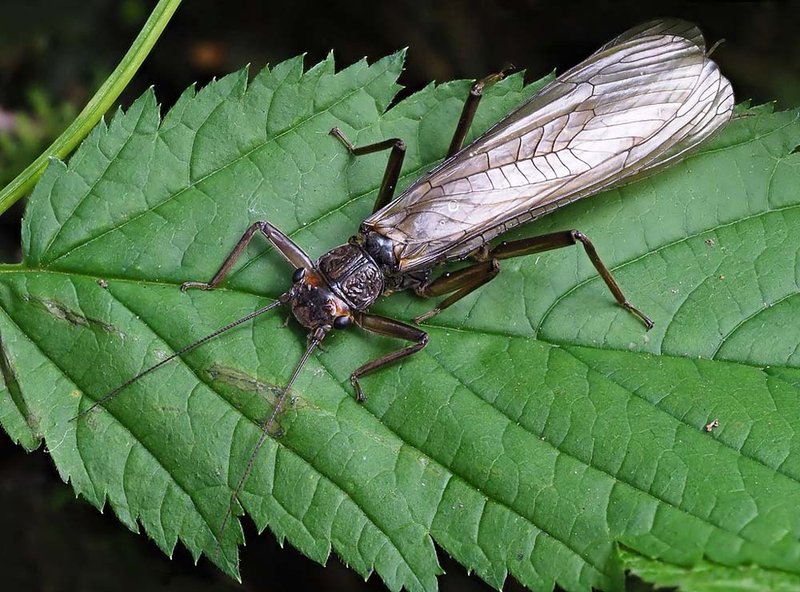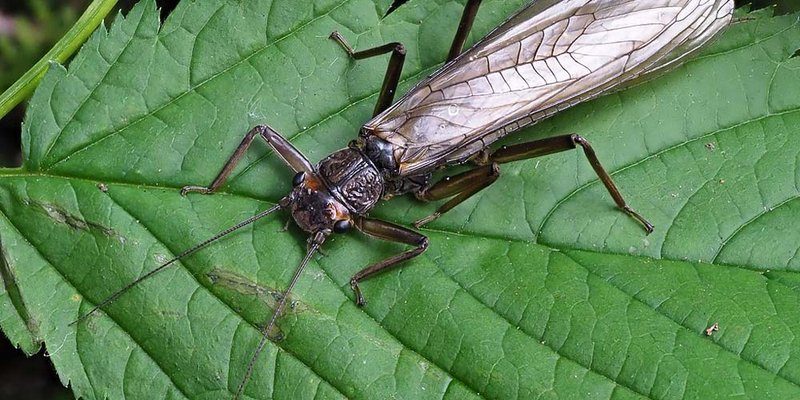
Imagine a tiny, delicate insect that thrives in clean, flowing water. That’s a stonefly for you! These fascinating creatures are often found in streams and rivers, fluttering around in their adult form. Stoneflies belong to the order Plecoptera, and they are known for their unique life cycle, which includes both aquatic nymphs and flying adults. While they might not be the first insect that comes to mind when you think about nature, stoneflies play a crucial role in their ecosystems.
They’re not just pretty faces either; stoneflies are also indicators of water quality. The presence of stoneflies often suggests that the water is clean and oxygen-rich. So, next time you’re near a stream or river, take a moment to appreciate these little guys. They might just be more important than you think!
Physical Characteristics
Stoneflies are typically medium-sized insects, with adults measuring between 10 to 30 mm in length. They have long, slender bodies and two pairs of membranous wings that often rest flat against their backs. One distinguishing feature is their two long cerci (tail-like appendages) at the end of their abdomen, which can be quite helpful for navigating their aquatic environment.
Their colors vary, but many species exhibit a mix of browns and greens, allowing them to blend into their natural surroundings. This camouflage is essential for avoiding predators, such as fish and birds. As nymphs, they are usually darker and have a more robust appearance, with gills located on their abdomen, facilitating underwater respiration.
One particularly interesting aspect of stoneflies is their adaptability. Some species have evolved to live in a wide range of habitats, from fast-flowing mountain streams to slower-moving rivers. This versatility is key to their survival and contributes to their presence in various aquatic ecosystems across the globe.
Life Cycle of a Stonefly
The life cycle of a stonefly is as intriguing as it is complex. It begins with the female stonefly laying her eggs in or near clean water. After a few weeks, the eggs hatch into nymphs. These nymphs live underwater for a period that can range from a few months to several years, depending on the species and the environmental conditions.
During their nymph stage, they undergo multiple molts, shedding their exoskeletons to grow. This stage is critical as they feed on organic matter, algae, and other small organisms, contributing to the nutrient cycle in their habitat. The nymphs are not only important in their own right, but they also serve as a vital food source for fish and other aquatic animals.
Eventually, as nymphs reach maturity, they will crawl out of the water, often onto rocks or vegetation, to metamorphose into adults. This process, known as emergence, is risky but essential. Once they transform into adults, they only live for a few weeks. However, in that short time, they will mate, lay eggs, and thus continue the cycle.
Habitat and Distribution
Stoneflies are found in a variety of aquatic environments, but they are particularly fond of cold, clean streams and rivers. In North America, stoneflies thrive in areas with plenty of riparian vegetation, which provides both shade and food. You might encounter them in mountainous streams, forested rivers, or even in some lakes.
Their distribution varies by species, with some stoneflies being relatively widespread while others are more localized. Generally, you can find stoneflies in regions with a temperate climate, where they can benefit from seasonal changes in water levels and temperature.
Seasonal changes play a significant role in their habitat preferences. During spring and summer months, adults tend to be more active, flying around to mate and lay eggs. When winter rolls in, some species enter a dormant state as nymphs, whereas others may die off, only to emerge again when temperatures rise. This adaptability is key to their survival in diverse climates and conditions.
Diet and Feeding Habits
As nymphs, stoneflies are primarily herbivorous, feeding on algae, decaying leaves, and other organic matter found in their aquatic habitats. They have specialized mouthparts that allow them to scrape or chew through their food sources. This diet plays an essential role in the ecosystem by helping to break down organic material and contribute to nutrient cycling in the water.
When they mature into adults, their feeding habits change significantly. Adult stoneflies often feed on plant matter, such as leaves and flowers. They may also consume small insects. This shift in diet is important for completing their life cycle, as it provides the energy needed for reproduction.
Interestingly, their feeding habits vary depending on the species and environmental conditions. Some may become more opportunistic when food is scarce, taking advantage of whatever is available. This adaptability is important for their survival, especially in areas where food sources can be unpredictable.
Importance in the Ecosystem
Stoneflies are more than just interesting insects; they play a vital role in their ecosystems. Their presence is often an indicator of water quality, as they tend to thrive in clean, well-oxygenated environments. This makes them invaluable for monitoring the health of aquatic ecosystems.
As both nymphs and adults, stoneflies contribute to the food web. Nymphs are a primary food source for fish, birds, and other predators, helping support larger populations of these animals. In turn, healthy populations of fish can indicate a thriving stonefly community.
Furthermore, stoneflies help maintain the balance of their aquatic habitats. By feeding on organic matter and algae, they contribute to the breakdown of materials that could otherwise accumulate and disrupt water quality. This role is crucial, especially in ecosystems where nutrient levels can fluctuate significantly.
Threats and Conservation
Despite their importance, stoneflies face various threats in their habitats. Pollution, habitat destruction, and climate change are major concerns. The introduction of chemicals from agriculture and urban runoff can lead to water quality degradation, which directly impacts stonefly populations. For instance, increased sedimentation can smother nymph habitats and hinder their development.
Habitat loss is another significant issue. When rivers are dammed or redirected, the natural flow of water is disrupted, affecting the ecological balance of the environment. This can reduce the availability of suitable habitats for stoneflies and other aquatic organisms. Moreover, climate change poses risks through altered precipitation patterns and rising temperatures, which can affect water levels and quality.
Conservation efforts are essential to protect stonefly populations. This includes habitat restoration projects, pollution reduction initiatives, and monitoring programs to keep track of their populations. By advocating for cleaner waters and preserving natural habitats, we can help ensure these fascinating insects continue to thrive in our ecosystems.
| Characteristic | Details |
| Size | 10 – 30 mm |
| Habitat | Cold, clean rivers and streams |
| Diet | Algae, decaying organic matter, small insects |
| Lifespan | Adults live for a few weeks; nymphs can live for several years |
| Threats | Pollution, habitat loss, climate change |
FAQ
How can you identify a stonefly?
Identifying a stonefly can be a fun challenge! Look for their long, slender bodies and two pairs of wings that rest flat on their backs. They also have distinctive cerci, or tail-like appendages, which can help separate them from other insects. If you’re near a clean stream or river, their presence is a strong indicator that you are looking at a stonefly!
Are stoneflies dangerous to humans?
No, stoneflies are not dangerous to humans. They do not sting or bite, making them harmless. In fact, their role in nature is more beneficial than anything else. They help indicate clean water and contribute to the health of their ecosystems. They’re more of an indicator species rather than a threat to humans.
What do stoneflies eat?
Throughout their life stages, stoneflies have different diets. As nymphs, they primarily consume algae and organic matter, while adults tend to eat plant material and sometimes smaller insects. This varied diet contributes to the health of the aquatic ecosystem by breaking down organic matter and promoting nutrient cycling.
Where can you find stoneflies?
Stoneflies are commonly found in cold, clean streams and rivers. They thrive in environments with abundant riparian vegetation that provides food and shelter. If you’re exploring a mountainous or forested area, keep an eye out for these insects near flowing water!
What role do stoneflies play in water ecosystems?
Stoneflies serve several crucial functions in aquatic ecosystems. They are bioindicators, meaning their presence indicates good water quality. Additionally, they contribute to the food web by serving as prey for fish and birds, while their feeding habits help break down organic material, promoting nutrient cycling within their habitats.
Can stoneflies be found in urban areas?
While stoneflies prefer clean, natural habitats, they can sometimes be found in urban areas if the conditions are right. However, pollution and habitat alteration can make it difficult for them to thrive. Urban streams that are well-maintained and have good water quality might support stonefly populations.
How do climate changes affect stonefly populations?
Climate change can significantly impact stonefly populations by altering water temperatures and flow patterns. Warmer water can reduce oxygen levels and disrupt the delicate balance of aquatic ecosystems. Changes in precipitation can also affect their habitats, making it crucial to monitor how these factors influence stoneflies and their environments.
Are all stoneflies the same species?
No, there are over 3,500 species of stoneflies worldwide, each adapted to different environmental conditions. While they share common characteristics, like their life cycle and habitat preferences, each species has its unique traits. This diversity allows them to occupy various niches in aquatic ecosystems.
Why are stoneflies important for fishing?
Stoneflies are an essential food source for many fish species, making them crucial for anglers. Many fish, especially trout, rely on stoneflies during specific times of the year when the insects emerge. Understanding their life cycle helps anglers know when to fish and what types of flies to use as bait, enhancing the fishing experience.
How can we help protect stonefly habitats?
Protecting stonefly habitats starts with advocating for clean water initiatives and conservation efforts. You can help by reducing chemical use near water bodies, participating in clean-up efforts, and promoting environmental awareness. Supporting local conservation organizations can also make a significant difference in preserving these vital ecosystems.

